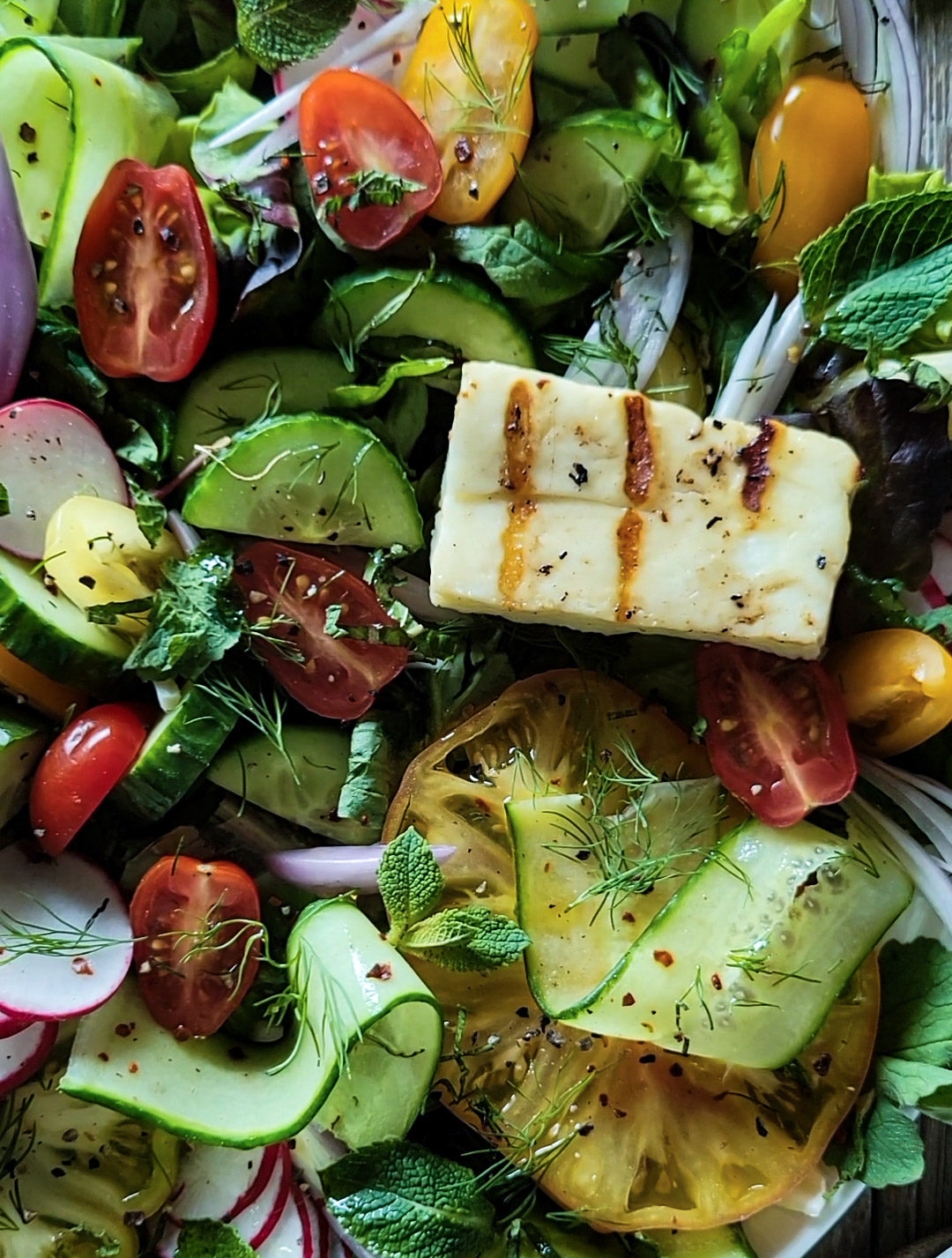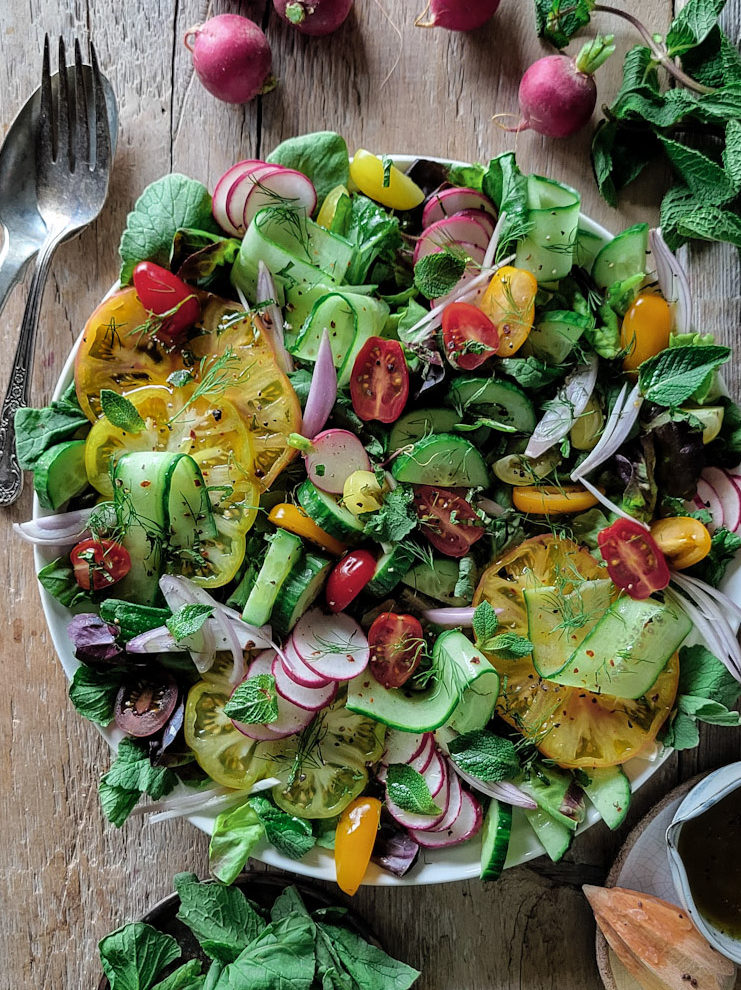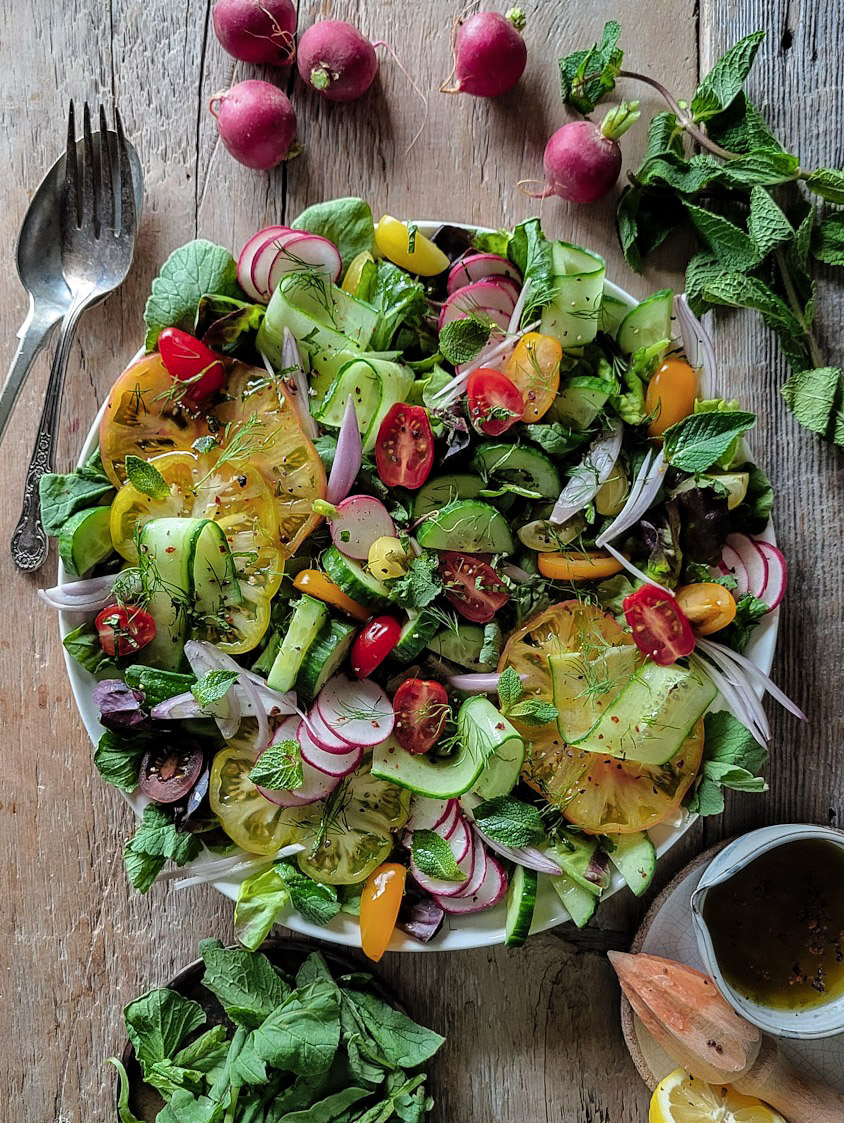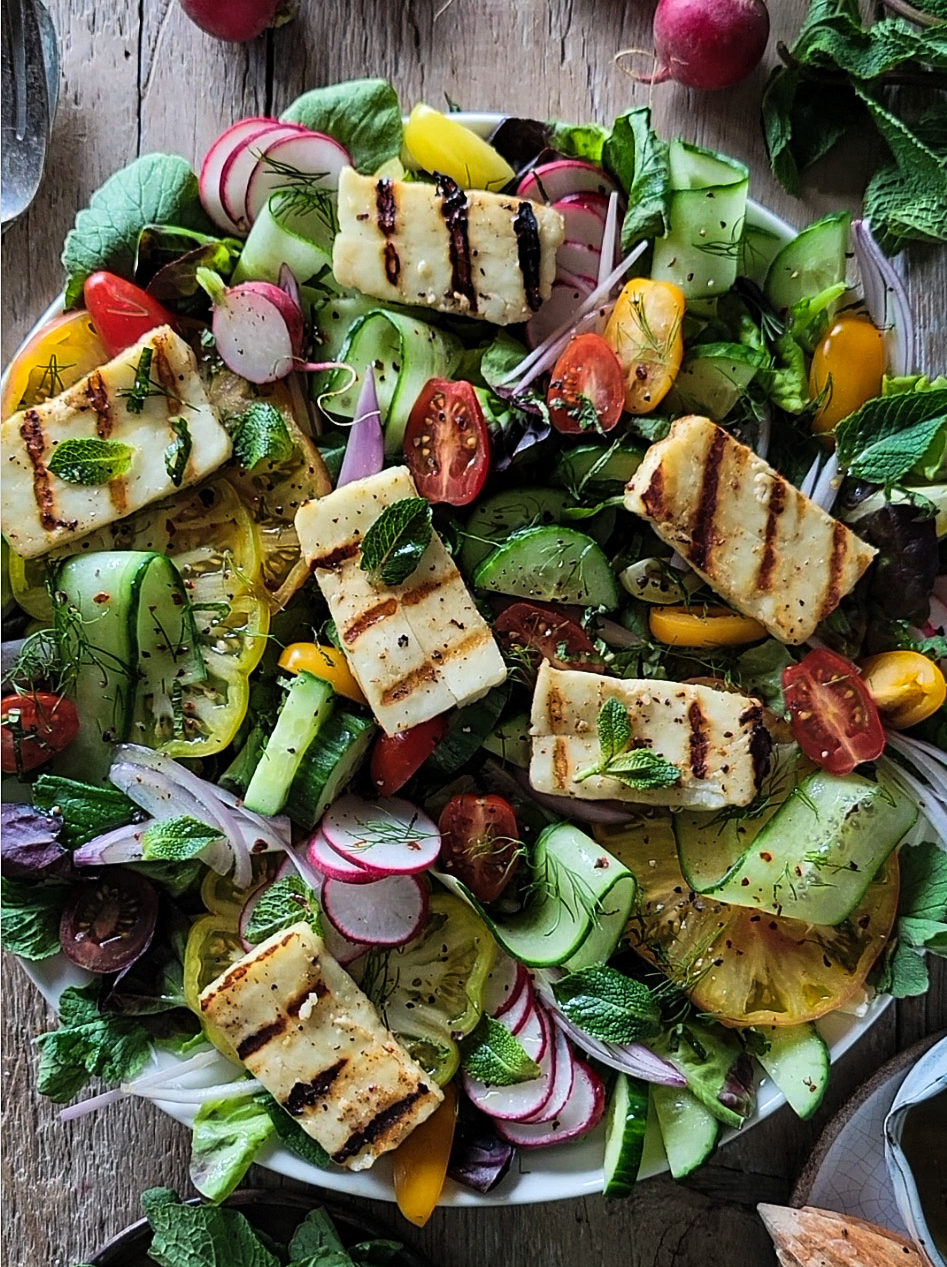This bright, fresh salad is one of life’s simple joys.
 I can’t imagine not wanting this amazingly satisfying and refreshing salad on any day of the year. So this goes all the more so for our hot and humid summer months.
I can’t imagine not wanting this amazingly satisfying and refreshing salad on any day of the year. So this goes all the more so for our hot and humid summer months.
Fattoush Salad has its roots in the Levantine cuisines, those lovely Middle Eastern cuisines that celebrate fresh vegetables, herbs, and wonderful happy spices like Sumac, Za-atar, Aleppo Pepper, Urfa Biber etc.
What goes into a traditional Fattoush Salad?
Like its cousin Tabbouleh, you will usually find a Fattoush Salad combining tomatoes, cucumbers, onions, even radishes, and herbs like mint, parsley or dill. However, unlike Tabbouleh, where the ingredients are chopped into small pieces, a Fattoush salad allows for a chunkier cut. Tabbouleh uses bulgur as the grain of choice, while Fattoush puts old pita bread to use (Fatteh basically means crumbs, hence the name of the salad). Think of this as a Middle Eastern Panzanella or Bread Salad. The pita bread is torn into bite sized pieces and then grilled or toasted in some way. The signature note or flavour that sets Fattoush apart is the use of citrusy sumac, a spice ground down from sumac bush berries, and pomegranate molasses. Pomegranate molasses lends a sweet tart note to the dressing. You will also find that some like to finish their Fattoush with a sprinkle of pomegranate seeds.

How to Prepare Fattoush
If you want to create a bed of crunchy greens for the veggies to sit on, you can use chopped romaine lettuce, or massaged kale, or even baby spinach (definitely not traditional!!) Wash and dry well, and place them in your bowl first.
Then add the chopped veggies:
- Tomatoes: I usually use cherry tomatoes just for ease, but feel free to use seeded Roma or Plum tomatoes, chopped into smaller pieces.
- Onions: Red onions (or why not shallots?), sliced thinly. Or why not use scallions or green onions, chopped?
- Cucumbers: Persian or mini cucumbers sliced into bite sized pieces, but of course you can use an English cucumber, just cut them into half moons first, and if you use a garden cucumber, you may want to peel away the thicker skin.
- Radishes: slice thinly for best results. And here is a fun addition to the greens, why not use the radish leaves if they are in good shape!? They have a lovely, peppery flavour not unlike arugula or chicory. Tear them and add them to the chopped lettuces you are using.
- Herbs: Parsley, dill, mint, these all work wonderfully in a Fattoush salad. Chop finely, or even leave some leaves larger and treat them as part of your greens base.
- Peppers: While not necessarily in some recipes, if you want to add chopped bell peppers (a la a Greek Horiatiki or Village Salad) I think its a great idea!
Dressing
The dressing is easy: just a combination of olive oil, lemon juice, pomegranate molasses, sumac, sugar, salt and pepper. Whisk and pour over and toss just before serving. If for some reason you just can’t source sumac, feel free to replace it with freshly grated lemon zest.
Finish with pomegranate arils, and more chopped herbs if you are feeling it.

But Where is the Bread?
Here is where this Fattoush Salad deviates from the traditional method. No pita bread in any form. Sure of course you can use bread (see my first version in my Za-atar Chicken and Fattoush Salad post, back in 2016) But being gluten free, I have gotten used to using less bread in my meals. Of course, if I happen to have some gluten free pita or flat bread on hand, it will go in, along with…
… Halloumi Cheese! The squeaky cheese! It’s a semi-hard, unripened brined cheese from Cyprus. It’s made from a mixture of goat and sheep milk. It kind of tastes like a combination of fresh Mozzarella and feta. This cheese withstands heat when sautéed, grilled or baked. It doesn’t melt, but rather softens to a slightly gooey interior and releases it slightly briny salty flavour. You will slice a brick of halloumi into even slices, about 1/2 inch or 1 cm thick. Then brush it with olive oil, and sprinkle sumac on the slices to prepare for cooking:
Grilling Halloumi: Prepare your outdoor grill by heating it to a medium heat (about 375F) Place the slices of cheese on the grill and brown on both sides, about 2-3 minutes per side, or until grill marks have been achieved. Adjust the heat if scorching. If you want, you can also prepare the grill itself by brushing it with a little oil to help with easy release. But do not spray the grill, it will smoke, brushing or using paper towel is better.
Stove top: Heat your pan over medium heat, and then add olive oil to just coat the bottom. You can still lightly brush the cheese with oil, so that the sumac adheres.
Baking Halloumi: Place it in an oven proof baking dish or baking sheet, brush with oil and herbs or spices. Bake at 400F for about 15 minutes, turning once.
You really don’t need to salt Halloumi, since it already has enough salt. But lemon juice and pepper are a wonderful way to finish halloumi, no matter how you are serving it.
Halloumi is best served right after cooking it, it gets rubbery when left to go cold.

Final Thoughts
This salad will go with everything! It’s practically a meal all unto itself with the cheese. But feel free to serve it as a first course, or with your favourite grilled meats or fish. Here are some fun options:
Mediterranean Pork Souvlaki with Labneh Tzatziki

Fattoush Salad with Grilled Halloumi
Ingredients
Fattoush Salad
- 1 head of hearts of romaine lettuce, chopped, can use 3 little gems lettuce instead, see Notes
- 3 Roma tomatoes, diced, or 12-15 cherry tomatoes, halved
- 2-3 Persian cucumbers, cut into half moons, or 1 English cucumber, quartered
- 5 radishes, sliced thinly
- 1/2 green pepper, chopped, optional
- 2 shallots, sliced thinly, or 3 green onions, chopped
- 1/4 cup fresh chopped parsley
- 1/4 cup fresh chopped mint
- 2 tbsp pomegranate arils, garnish, optional
Dressing
- 3 tbsp olive oil
- 2 tbsp lemon juice
- 2 garlic cloves pressed or grated
- 1 tsp sumac
- 2 tsp pomegranate molasses see Notes
- 1 tsp sugar
- 1/2 tsp dried mint
- 1/2 tsp salt
- 1/4 tsp Fresh cracked black pepper, or more to taste
Grilled Halloumi
- 1 package halloumi cheese
- 2 tsp olive oil
- 1 tsp sumac
Instructions
Dressing, can be made in advance
-
Whisk all the ingredients in a small bowl. Alternatively, place them all in a glass jar with a lid. Shake till well blended. Taste and re-season as desired. This can be stored in the fridge till needed, but bring back to room temperature before using, as the olive oil may have solidified.
Fattoush Salad
-
Combine all the ingredients in a bowl. If preparing in advance, layer in the following order: tomatoes, cucumbers, onions, pepper, radishes, lettuce, parsley and mint. Lay a damp paper towel over the bowl and place in the fridge. The paper towel will ensure that everything stays fresh and crisp till ready to serve.
Grilled Halloumi Cheese
-
Slice the cheese into 1/2 inch (1 cm) thick slices, going from the side to ensure that the interior seam stays intact. You may not see it at first, but the way the cheese is pressed, there is a naturally occurring seam trapped on the inside.
-
Brush each side of the slices with a little olive oil. Sprinkle with the sumac.
-
Heat the outdoor grill or a stovetop grill pan on medium heat. You can also brush the grill with a little more olive oil to ensure that the cheese doesn't stick.
-
Place the cheese on the grill or in the pan (work in batches if necessary) and grill each side for 2-3 minutes, or until the grill marks are evident and the cheese releases easily. Serve on the salad immediately.
Assembly
-
Dress the salad with most of the dressing. Lay the grilled cheese over the salad. Finish with the remaining dressing, and pomegranate arils if using. You can also sprinkle with extra herbs if desired.
Recipe Notes
You can use any lettuce you like. If kale is in the fridge, go for it, just massage it between your fingers to help it become softened for pleasant eating.
If you can't source pomegranate molasses, then feel free to replace with an aged syrupy balsamic vinegar. However, I do encourage you to get a bottle of pom molasses, you will use it alot!

I love the idea of the cheese substituting for the bread. I makes perfect sense to me! Beautiful photos.
Hi Mimi, Thanks, I thought so as well, so happy you like! Love Jen